Jacobs’s quote was next to one from hometown hero Drake, "When I think of myself, I think of Toronto." Neither the Drake nor the Jacobs quote required context or an explanation of either source's pedigree. It’s unlikely a retail management company anywhere else in North America would assume that Jacobs wouldn’t require a line of biography. But Jacobs is the patron saint of urban-minded Toronto, a benevolent specter watching the evolution of the city she called home for the second half of her life.
Jane Jacobs’s name appearing in Toronto is not unique nor a surprise, but finding it at the mall defies local conventional wisdom. The mall? Ewww. Urbanista Toronto is rife with the sentiment that the Eaton Centre is a place to be avoided at all costs. Inauthentic, crass, and boorish, it’s for people who’ve not yet been enlightened to a better urban way of life, one of cozy neighborhood strips with cafes and cupcake stores. Conventional urban wisdom here might suggest a much more appropriate place for a Jane Jacobs quote is a few kilometers west at a building well known in arts and culture circles in Toronto: 401 Richmond. A massive former factory that produced lithography on tinware products, its various sections were built between 1899 and 1923, but today it’s filled with arts organizations, galleries, studios, magazine offices, artist unions, designers, podcasters, and even one fellow who still fashions pieces of guerrilla art out of copper and other bits of metal and attaches them to utility poles around the city. Jane Jacobs quotes and pictures are here, too, part of an exhibition on her life and work that has been permanently installed inside, but her connection to this building is even deeper.
:no_upscale()/cdn.vox-cdn.com/uploads/chorus_asset/file/6429087/401.jpg)
401 Richmond.
In fact, 401, which the Zeidler family purchased in 1994, is an illustration of Jacobs’s arguments about urbanism and a piece of her legacy in Toronto. Eberhard Zeidler, the patriarch, was the architect who designed the Eaton Centre. When the Zeidlers purchased 401, the old steampunk neighborhood around it, once the heart of Toronto’s schmatte trade, was dead. "There was one restaurant in the area, just a greasy spoon. Now there has to be like 20 or 30 in that section there," says Margie Zeidler, Eberhard’s daughter and the driving force behind what would become the vital building beloved by so much of Toronto today. Today that 1994 landscape is unimaginable and the building is at the heart of one of the most intense areas of development in North America, with condo towers sprouting where there were once acres of parking lots and buildings left fallow after deindustrialization.
"The one thing that really struck me was that chapter about new ideas needing old buildings," says Margie Zeidler of Jacobs’s The Death and Life of Great American Cities. "The city needs inexpensive space where people involved in low return pursuits, like inventing things or writing something, can find cheap rent to support that kind of user. She said you don’t want to have a city full of shiny new buildings because you won’t generate new ideas. I remember that hitting me like a ton of bricks. Having been related to an architect and going to architecture school myself, I always thought the purpose of architecture was to make the world more beautiful and fix everything up, but I realized then that if we do that we lose a lot." The Zeidlers befriended the Jacobs family when they arrived in Toronto in 1968, when Robert Jacobs, an architect who specialized in hospitals, got a job at Eberhard’s firm. Margie grew up with them as frequent houseguests, though she says it wasn’t until she went to architecture school that she read Jane’s work.
Jacobs is the patron saint of urban-minded Toronto, a benevolent specter watching the evolution of the city she called home for the second half of her life.
With that chapter from Death and Life at their elbow, the Zeidlers renovated 401 and began filling the building with tenants, often arts people, the only use the zoning allowed at the time. With 401 Richmond, as with so many other things in the city, Jacobs wielded a kind of soft power, influencing elected officials, planners, (some) developers, activists, and the general public. She also had more direct influence: the area around 401 changed radically in part because Jacobs worked with then-mayor Barbara Hall on what became known as the "Two Kings," a 1996 bylaw change that allowed for mixed uses in two worn-out historic industrial zones, one at King and Parliament Streets on the east side of downtown, the other around King and Spadina on the west side, where 401 is located. The change allowed Margie Zeidler to fill the building with other kinds of cultural tenants, while tech, design, and other new businesses moved into buildings nearby.
"The Kings was really interesting," says Ken Greenberg. "Hall was elected and reached out to various people, excited to do things, and Jane was one." She also reached out to Greenberg, an urban designer and friend of Jacobs since 1968, a fellow New York transplant and draft resister. Throughout his career in Toronto and elsewhere, he called on Jacobs for advice, stories he recounts in his 2011 memoir Walking Home: The Life and Lessons of a City Builder. "The idea was to take these two industrial areas, 400 acres on both sides of downtown, and literally apply some of Jane’s ideas about zoning for mixed use, as she called it, from Death and Life, and do a living experiment in Toronto. It’s a tremendous homage to Jane Jacobs, and as time went on she could see what happened and was absolutely fascinated in how it was being interpreted, what worked and what didn’t. Everything was a big R&D lab for her; it was trial and error, seeing what succeeded, admitting when there was failure." Greenberg says that the evolution of the Two Kings neighborhoods after the bylaw change was a concrete manifestation of her ideas, pioneering in developing mixed-use, mixed-income, and mixed-people neighborhoods.

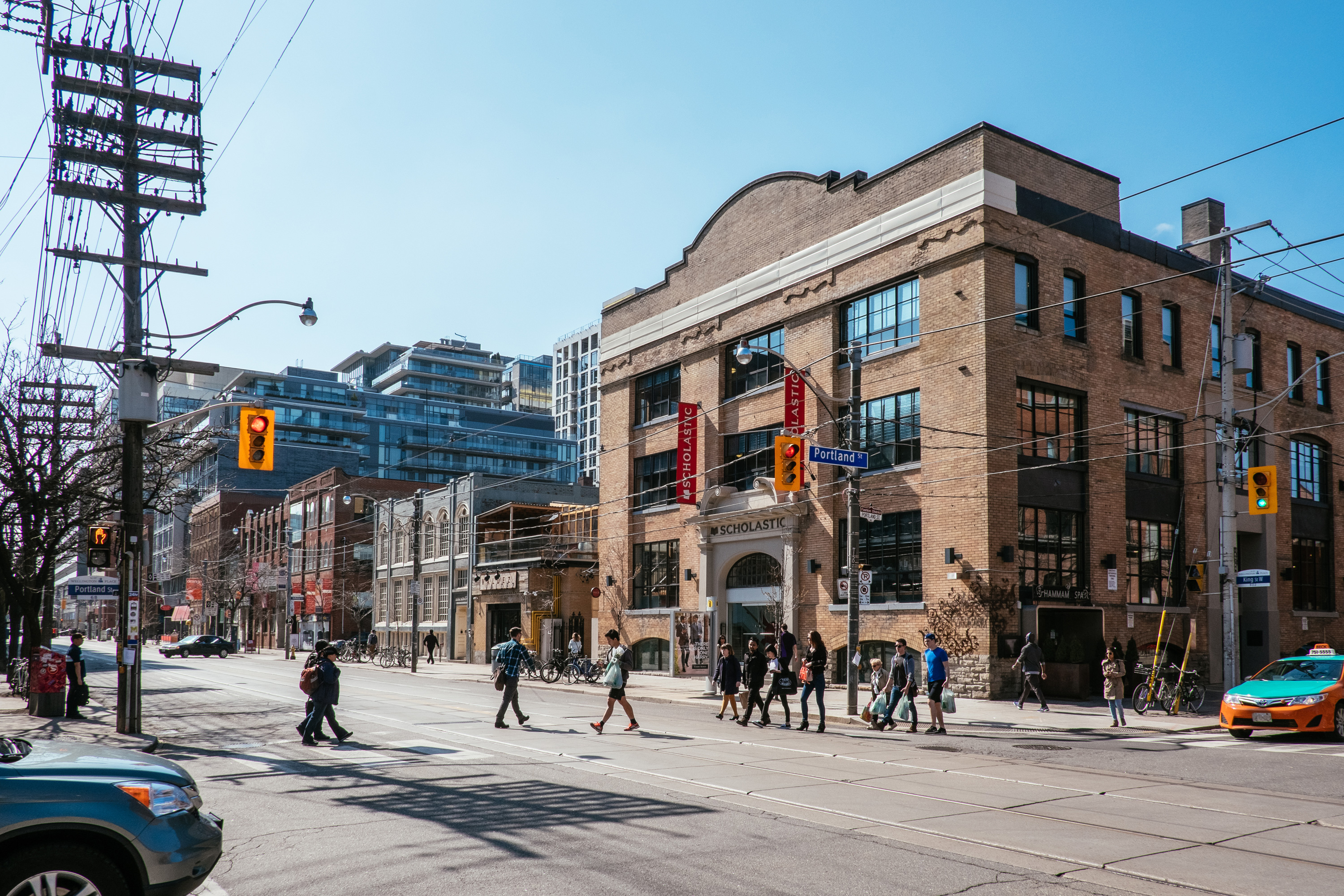
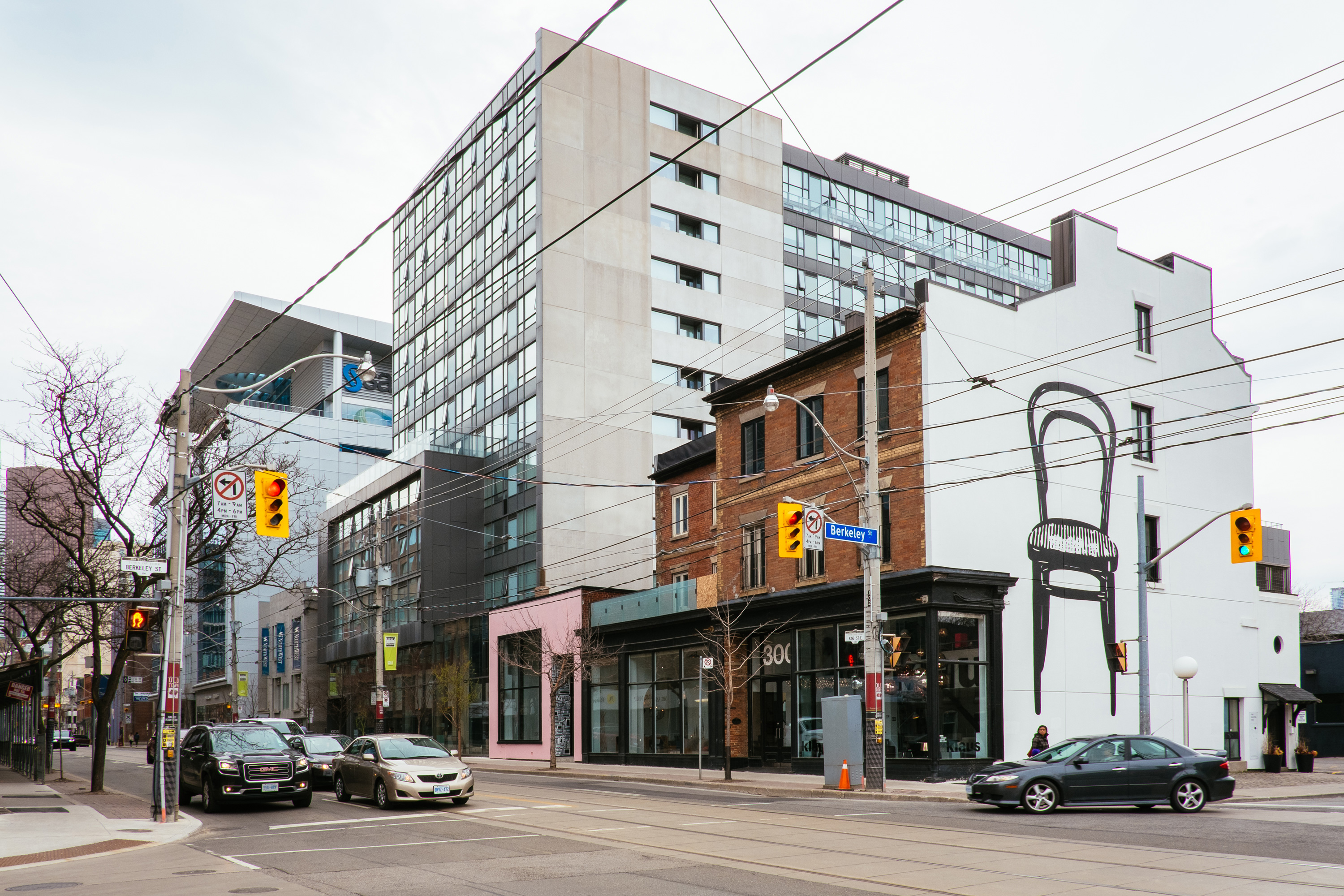

Left: King West; right: King East.
Nearly two decades earlier, while Greenberg headed up Toronto’s urban design department between 1977 and 1987, he and others had worked with Jacobs to redevelop the polluted railway lands just a few blocks east of the downtown residential core. Today it’s known as the St. Lawrence neighborhood, named after the adjacent city market, and is widely heralded as an urban success, a dense cluster of affordable housing, co-ops, market rentals, and condos that integrated parks, schools, and other community services into the mix. "She was a mentor for St. Lawrence neighborhood. We would go to her to get advice, she would point out things in the fabric of Toronto, things people should incorporate in new development," says Greenberg. "It was about mix in all its senses, it was about walkability, small blocks, heritage; it kind of all came together."
Jacobs and her family arrived in Toronto in 1968 with their daughter and two draft-age sons, first settling in a rented house on Spadina Road in The Annex, an intellectual neighborhood near the University of Toronto populated by students and professors. It was also a neighborhood of rooming houses carved out of once-grand homes and a place where some of the 40,000 American draft resisters who fled to Canada settled. Almost immediately, Jacobs was caught up in an ongoing battle against an expressway plan that was to drive a vast gash through the neighborhood, embracing her new city with vigor as both an advocate and a critic. "Those were exciting times," says Jim Jacobs, her son. "Toronto had a major growth spurt between 1956 and 1966 and was an amazing and exciting place, not stagnant. That’s the essence of what she appreciated the most about Toronto. The rest of the details sort of come out of that." In City Limits, a National Film Board of Canada documentary about Jacobs produced in 1971, she said Toronto "is a city that still has options...it hasn't made so many mistakes that it's bound to go downhill."
:no_upscale()/cdn.vox-cdn.com/uploads/chorus_asset/file/6433951/GettyImages-450390630_Current_house_images_combined.0.jpg)
Many people who knew her here have similar stories of their first meeting. Often it was an encounter at a community meeting, or a shy request for help on an issue and an invitation from Jane—Toronto is often on a first name basis with her—to come over and talk it through. Even a Jane Jacobs sighting was a thrill. My own was during the 2003 mayoral election, when Toronto was slowly coming out of the doldrums of a radical municipal reorganization process. City councilor David Miller captured the spirit of the moment and steadily rose in the polls until an event a few weeks before the November election at the Gladstone Hotel, an old railway hotel that was renovated into an arts and culture hub by, yes, the Zeidler family.
Miller was scheduled to lecture on "Beauty & the Aesthetic City," and Jacobs, who had endorsed Miller, was to speak about whether or not Toronto was in decline. When I arrived, the line for the event ran down the block and most, including me, did not get in. When I walked to the front of the line before leaving, a car pulled up and out came Jane Jacobs, ushered in along with the Victrola-like horn she brought to public meetings to place up to her ear to hear better. Miller ran, among other things, on a platform that opposed a bridge to the Toronto Island airport, something Jacobs herself had opposed earlier.
Jacobs was an inspiration for the magazine I help run, Spacing, which was being founded at that time. We’ve since opened a "city store," selling urban-themed goods, books, and the magazine in one of the sidewalk-fronting corners of 401 Richmond. We even make and sell t-shirts that read, "What Would Jane Jacobs Do?"
"I hate those t-shirts," says Mary Rowe, an urbanist and civic entrepreneur who befriended Jacobs in the mid-1990s. "You could never predict that, she was really not an ideological person. She was methodically observant and exceptionally well read. Her brain was just wired differently, and it would lead to unexpected conclusions." Indeed, one of Jacobs’s legacies in Toronto is a continued use of her name as either a battle flag or a shield by parties on all sides of the urban scene—developers, affordable housing activists, gentrifiers, anti-gentrifers, and the most ardent NIMBYs who know Jane would have hated whatever it is they’re opposing. Everybody uses Jane Jacobs in Toronto. "It sort of amazed her because it was already going on while she was alive," says Jim Jacobs. "You had the most crazy ideologists claiming ‘look here Jane proves this, that our ideology is right,’ as weird as that sounds, because she was as anti-ideology as anyone. She wasn’t at all surprised to see people saying what would Jane Jacobs have thought; but what Jane Jacobs would have thought was think for yourself."
She often threw her support behind unexpected places, subverting what people thought she would do, and one of those was the Eaton Centre itself. As Jim Jacobs explains, when Eaton’s, the once-great Canadian department store empire, and their developer partner Cadillac Fairview planned to put a mall in downtown Toronto in the mid-1970s, the City of Toronto opposed it vehemently. "They were at complete loggerheads," recalls Jim Jacobs. To come to a compromise, the city brought in Jane Jacobs to represent their interests and Cadillac Fairview, partly owned by the Bronfmans (of Seagram company fame), brought in Bronfman heir Phyllis Lambert. "They had a very good time together," says Jim. "They agreed on almost everything. Jane had a lot of knowledge and experience in shopping center design as she had worked extensively with Victor Gruen, inventor of the shopping center. She thought a lot about how those principles of suburban shopping center design could work in the city." The two worked out the structure of how it would work and fit into the city, and Cadillac Fairview dismissed their original architect and hired Zeidler, and today Toronto urbanists have a building they love to hate that mall-studying Jane Jacobs helped create.

Eaton Centre.
Jacobs’s legacy in Toronto often centers on her role in stopping the Spadina Expressway in the early 1970s, but those who worked with her are careful to say she insisted she was just one of many, and that momentum was already there when she arrived on the scene. The narrative is too delicious to resist, though: Jacobs, hot off her underdog win against Robert Moses in New York, moved to Toronto and settled first on Spadina Road, the very place Toronto’s version of the Lower Manhattan Expressway was planned to obliterate. For many, the strength of that narrative led to sometimes exaggerated and wrongheaded claims of her influence on Toronto.
Richard White, a Toronto urban planning historian, recently published Planning Toronto: The Planners, The Plans, Their Legacies, 1940-80, an exhaustive study in which Jane Jacobs figures very little. "When I began researching the subject years ago I assumed that she would be everywhere, but I was wrong. Her name simply never came up," says White. "I will, however, emphasize the critical point that my study stops in 1980, by which time a new orthodoxy, or new ‘paradigm’ as I and others put it, which her writing had done much to create, was firmly in place. So her impact on cities everywhere (not just Toronto) is naturally more apparent in what has been done since 1980." It took a decade for the aura that now pervades Toronto urban circles to build up, and for demonstrative results to be visible in places like St. Lawrence and the Kings, and it’s that aura, or spirit, that may be her strongest legacy in Toronto.
She wasn’t at all surprised to see people saying what would Jane Jacobs have thought; but what Jane Jacobs would have thought was think for yourself. -Jim Jacobs
"In terms of her spiritual legacy, her ongoing interest in how you foster diversity in a city, how you need to have the kind of local autonomy to make decisions that allow a city to evolve in an authentic, unique way, and that artificial top-down rules are rarely effective, that to me is her legacy," says Rowe. "But that’s what I was exposed to. Just allowing cities to be cities." After her death in 2006, Rowe, Margie Zeidler, and another friend of Jacobs, conservation advocate Chris Winter, decided to honor her legacy by organizing what they called Jane’s Walks. "Chris came up with this idea that was interesting: what would happen if we encouraged people, in some kind of semi-formalized way, to take their eyes to the street around her birthday," says Rowe. "It was one of those simple, elegant ideas. Everybody agreed you didn’t want to concretize her in any way, naming a street or a park, that’s all too confining." Begun with a handful of walks that year, the annual Jane’s Walk event occurs over the first weekend in May and has spread to nearly 200 cities and 40 countries worldwide. The idea is that anybody can lead a walk: no particular expertise in an urban field is required, just an interest in exploring and talking about a bit of geography that is important to them. Sometimes they’re celebratory walks, other times quite critical. Jane’s Walks are a first encounter with Jacobs’s ideas for many.
"My view is different than historians'," says Denise Pinto, director of Jane’s Walks. "I’m experiencing the younger wave, and I was still in university when she was working on her last books, so I’m once removed. Older people might point to physical things in the city as her legacy but I see patterns of activism. She hasn’t gone away from our collective consciousness, for young and old alike." Pinto traces the work Jacobs and others did as a continuum of engagement with city issues that continue to this day. "In Toronto over the last decade or so we’ve had an incredible wave of young urbanists—some even call themselves that—who are following the trails that Jane blazed."
Those trails continue on in many directions, and don’t take her writing as orthodoxy, but as a place to start. Jane Farrow is representative of the kind of tactical Toronto urbanist who was influenced by Jacobs’s ideas but left parsing her books to others. "There’s almost a level of anti-intellectual guilt in just grabbing her five most compelling ideas like a total intellectual opportunist," says Farrow, the former director of the Centre for City Ecology, the not-for-profit organization that first incubated the Jane’s Walks, helping them spread across Toronto, particularly outside of the downtown Jacobs holy lands, into the suburbs, where her ideals of local knowledge and walkability could also be applied. During that first year of Jane’s Walks, Farrow had done research for a Toronto Life magazine article on the history of Yonge Street as a "gay mecca" that was spiked because the magazine wanted a story, explains Farrow, on where gays shop. "But I realized that’s a walking tour, because that’s where queers would go, to get lost in the crowd." The walk was a success and Farrow told Zeidler that she wanted to run with this idea and connect the stories people have to the history of the city. "Everything I needed in a basic recipe for urban activism was there," says Farrow. "I feel like Jane’s Walk was a brilliant intervention and I just popularized, like a magpie, the most easy, getable ideas. Many people who led Jane’s Walks had no idea who Jane Jacobs was and that was not a problem. The idea wasn’t to spread the cult of Jane, but ideas people could relate to, and if they realize later who Jane Jacobs was, bonus."
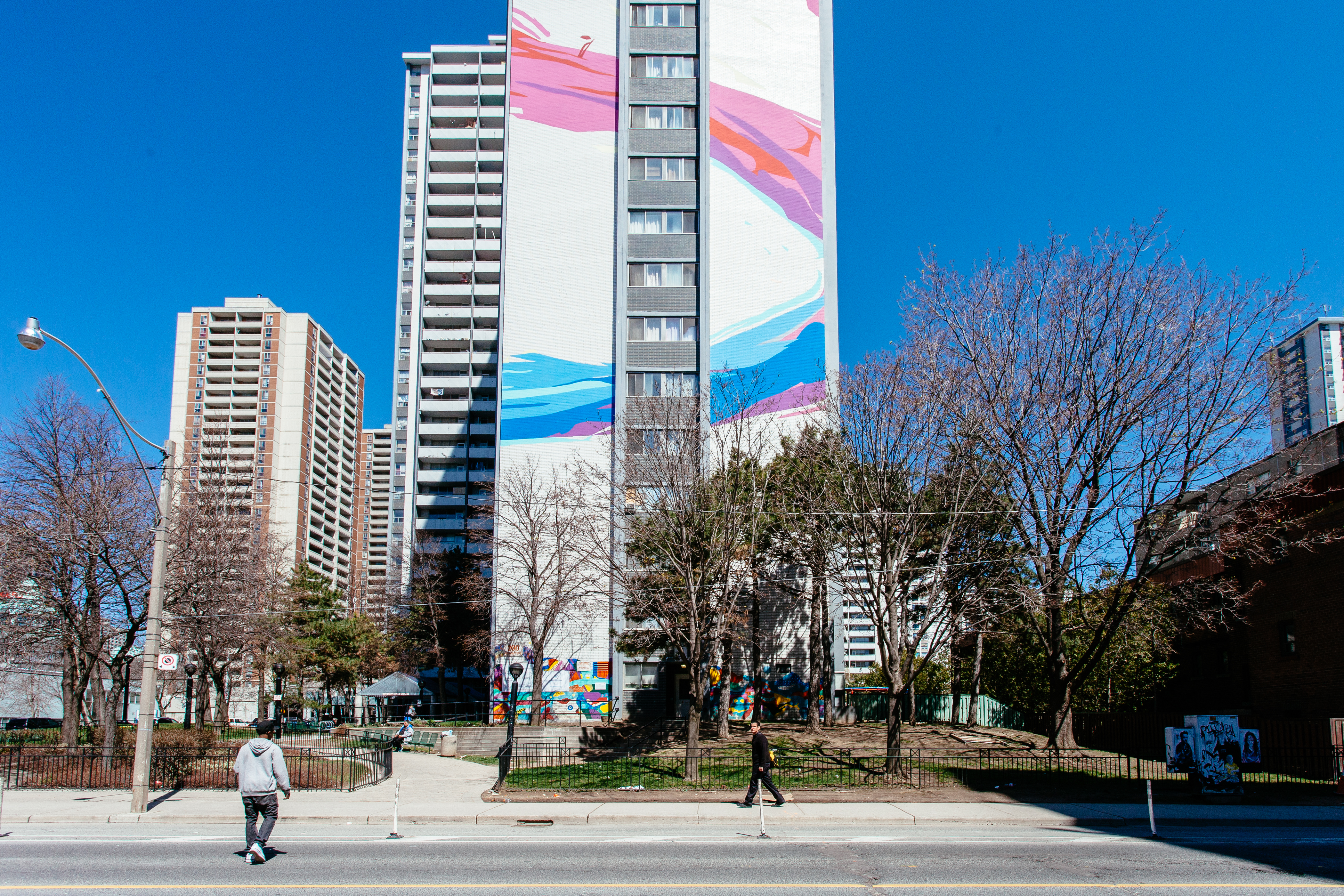
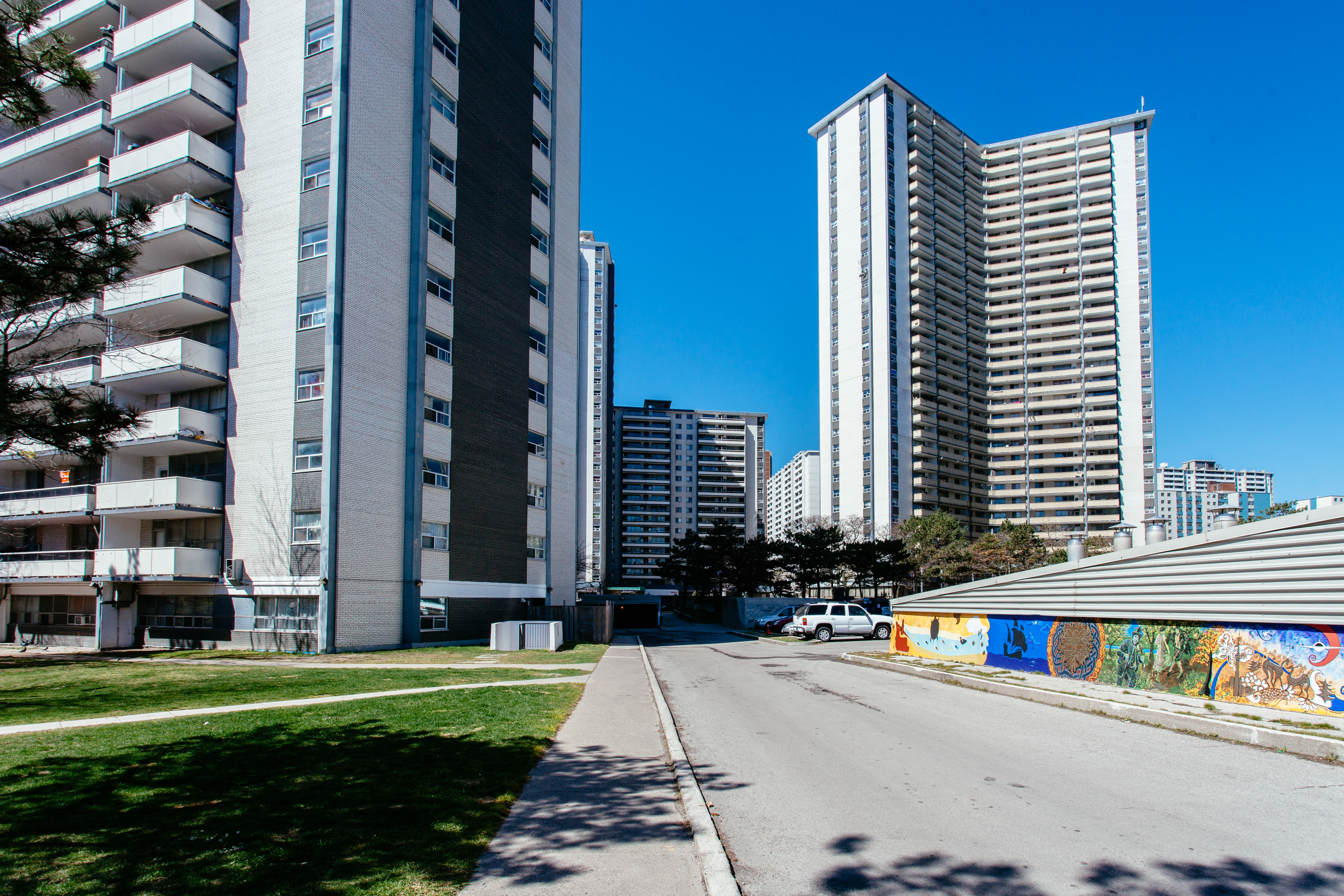
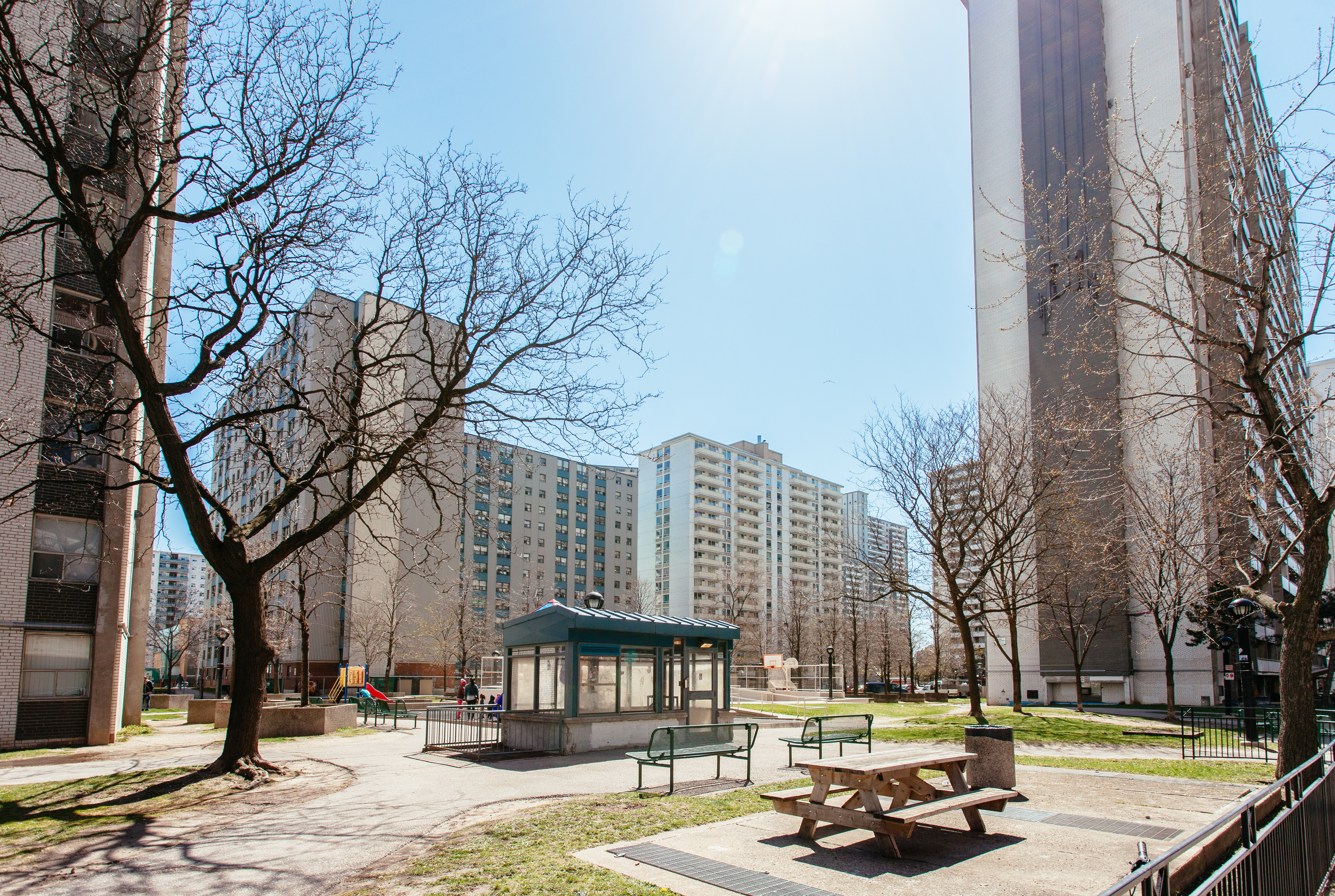
St. James Town, where many of the towers are in need of renewal.
To foster more of that soft power influence and celebrate individuals who contribute to the fabric of Toronto, the Jane Jacobs Prize was founded in 1997. Spacing was a recipient of the prize in 2010, and two years ago we became stewards of the prize, awarding $3,000 annually for three years to an established person and to somebody up and coming. In 2014, we gave the first award to Graeme Stewart, an architect who created "Tower Renewal," a program that revitalizes aging and sometimes impoverished apartment towers across Toronto, making them more efficient and allowing local economies to flourish. The emerging person was Sabina Ali, who in the six short years since she immigrated to Canada and settled in the Thorncliffe Park apartment tower neighborhood, a community designed for 12,000 but now home to 30,000, founded a women’s committee and revitalized the neighborhood park, complete with a public tandoor oven.
There are thousands in Toronto also deserving of this award, some of them directly influenced by Jacobs, others by that aura of hers, and others still who figured it out on their own. In concrete terms, her advocacy for dense, mixed-use, utterly urban neighborhoods has helped shape the city, but more broadly, her legacy is a spirit of activism and engagement with the city. Hers is a complex history here—she was a supporter of malls and affordable housing, waterfront development and city parks—and the ideas are forever interpreted and extrapolated and argued. Jane Jacobs is as alive as she ever was in Toronto.
Beginning in May, Jane100 is a year-long celebration of her life and legacy in Toronto with 100 events to "engage citizens in dialogue, action and the spirit of Jane." One of those is Jane at Home, an exhibit at 401 Richmond of artifacts from Jane’s domestic life curated by Jim Jacobs, granddaughter Caitlin Broms-Jacobs, and Margie Zeidler. It runs April 29-May 8.
Editor: Sara Polsky
Photographer: Tanja-Tiziana
/cdn.vox-cdn.com/uploads/chorus_image/image/49476573/stlawrence.0.jpg)